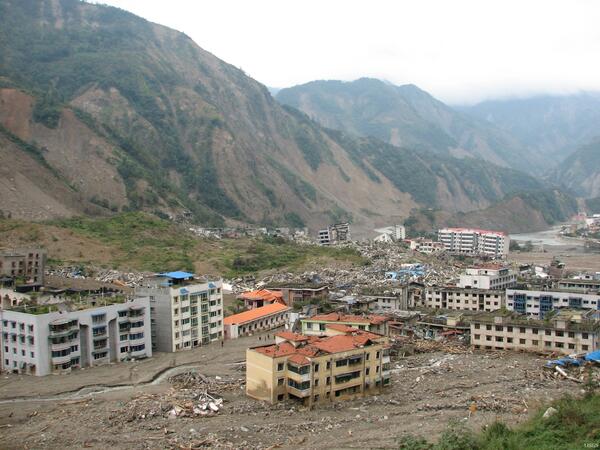The May 12, 2008, Great Sichuan Earthquake, also called the Wenchuan Earthquake, occurred at 14:28 local time, in Sichuan Province, China. The earthquake magnitudes were Mw = 7.9 (USGS), Ms = 8.0 (Chinese Earthquake Administration). The epicenter was 80 km west-northwest of Chengdu, the capital city of Sichuan province.
David J Wald
Dr. Wald is a Seismologist with the USGS in Golden. He is involved in research, development & operations of several real-time earthquake information systems at the USGS National Earthquake Information Center. He developed and manages “ShakeMap”, “Did You Feel it?”, & is responsible for developing other systems for post-earthquake response & pre-earthquake mitigation, including ShakeCas
Wald's scientific interests include the characterization of rupture processes from complex recent and historic earthquakes using combined geodetic, teleseismic, and strong motion data; waveform modelling and inversion; analysis of ground motion hazards and site effects; earthquake source physics; and modelling earthquake-induced landslides, liquefaction, and losses, macroseismic intensity, building damage, financial and human impact, rapid damage and impact assessment, earthquake scenario development and mitigation planning and drills, and communication with the media, public, and emergency managers.
Previously at Caltech, and now at the Colorado School of Mines, Wald has advised dozens of post-doctoral, graduate, and undergraduate student research projects. Wald directly supervises 10 PhD level scientists and 5 five BS and MS level support staff, and supervises several students. Wald serves on several PhD committees at this time. This research has resulted in more than 450 professional publications that David has authored or co-authored, including journal papers, USGS publication series, conference papers, and published abstracts.
Education:
Post-doctoral Fellow, Geophysics, National Research Council, USGS, Pasadena, 1995
Ph.D., Geophysics, California Institute of Technology, Pasadena, CA, 1993
M.S., Geophysics, University of Arizona, Tucson, AZ, 1986
B.S., Geology & Physics, St. Lawrence University, Canton, NY, 1984
Science and Products
Developing and Implementing an International Macroseismic Scale (IMS) for Earthquake Engineering, Earthquake Science, and Rapid Damage Assessment
The Blind Zone of Earthquake Early Warning
Future Opportunities in Regional and Global Seismic Network Monitoring and Science
Operational Earthquake Forecasting – Implementing a Real-Time System for California
A Global Hybrid Vs30 Map with a Topographic-Slope-Based Default and Regional Map Insets
An Open Repository of Earthquake-Triggered Ground-Failure Inventories
Shakemap earthquake scenario: Building Seismic Safety Council 2014 Event Set (BSSC2014)

The May 12, 2008, Great Sichuan Earthquake, also called the Wenchuan Earthquake, occurred at 14:28 local time, in Sichuan Province, China. The earthquake magnitudes were Mw = 7.9 (USGS), Ms = 8.0 (Chinese Earthquake Administration). The epicenter was 80 km west-northwest of Chengdu, the capital city of Sichuan province.
Developing and implementing an International Macroseismic Scale (IMS) for earthquake engineering, earthquake science, and rapid damage assessment
DisasterNet: Causal Bayesian networks with normalizing flows for cascading hazards
Alerting the globe of consequential earthquakes
Rapid characterization of the February 2023 Kahramanmaraş, Turkey, earthquake sequence
Causality-informed Bayesian inference for rapid seismic ground failure and building damage estimation
Critical ShakeCast lifeline users and their response protocols
Seismic multi-hazard and impact estimation via causal inference from satellite imagery
Assessing direct and indirect long-term economic impacts from earthquakes to the U.S. National Bridge Inventory
Applying consequence-driven scenario selection to lifelines
Earthquake scenario selection for portfolio holders in CEUS: A case study with Oklahoma DOT
Integrated strategies for enhanced rapid earthquake shaking, ground failure, and impact estimation employing remotely sensed and ground truth constraints
Improving the Development Pipelines for USGS Earthquake Hazards Program Real-Time and Scenario Products
Non-USGS Publications**
**Disclaimer: The views expressed in Non-USGS publications are those of the author and do not represent the views of the USGS, Department of the Interior, or the U.S. Government.
Did You Feel It?
Science and Products
Developing and Implementing an International Macroseismic Scale (IMS) for Earthquake Engineering, Earthquake Science, and Rapid Damage Assessment
The Blind Zone of Earthquake Early Warning
Future Opportunities in Regional and Global Seismic Network Monitoring and Science
Operational Earthquake Forecasting – Implementing a Real-Time System for California
A Global Hybrid Vs30 Map with a Topographic-Slope-Based Default and Regional Map Insets
An Open Repository of Earthquake-Triggered Ground-Failure Inventories
Shakemap earthquake scenario: Building Seismic Safety Council 2014 Event Set (BSSC2014)

The May 12, 2008, Great Sichuan Earthquake, also called the Wenchuan Earthquake, occurred at 14:28 local time, in Sichuan Province, China. The earthquake magnitudes were Mw = 7.9 (USGS), Ms = 8.0 (Chinese Earthquake Administration). The epicenter was 80 km west-northwest of Chengdu, the capital city of Sichuan province.
The May 12, 2008, Great Sichuan Earthquake, also called the Wenchuan Earthquake, occurred at 14:28 local time, in Sichuan Province, China. The earthquake magnitudes were Mw = 7.9 (USGS), Ms = 8.0 (Chinese Earthquake Administration). The epicenter was 80 km west-northwest of Chengdu, the capital city of Sichuan province.
Developing and implementing an International Macroseismic Scale (IMS) for earthquake engineering, earthquake science, and rapid damage assessment
DisasterNet: Causal Bayesian networks with normalizing flows for cascading hazards
Alerting the globe of consequential earthquakes
Rapid characterization of the February 2023 Kahramanmaraş, Turkey, earthquake sequence
Causality-informed Bayesian inference for rapid seismic ground failure and building damage estimation
Critical ShakeCast lifeline users and their response protocols
Seismic multi-hazard and impact estimation via causal inference from satellite imagery
Assessing direct and indirect long-term economic impacts from earthquakes to the U.S. National Bridge Inventory
Applying consequence-driven scenario selection to lifelines
Earthquake scenario selection for portfolio holders in CEUS: A case study with Oklahoma DOT
Integrated strategies for enhanced rapid earthquake shaking, ground failure, and impact estimation employing remotely sensed and ground truth constraints
Improving the Development Pipelines for USGS Earthquake Hazards Program Real-Time and Scenario Products
Non-USGS Publications**
**Disclaimer: The views expressed in Non-USGS publications are those of the author and do not represent the views of the USGS, Department of the Interior, or the U.S. Government.





